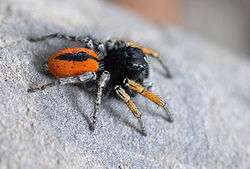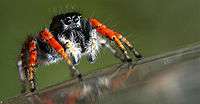Philaeus chrysops
| Philaeus chrysops | |
|---|---|
 | |
| Male | |
| Scientific classification | |
| Kingdom: | Animalia |
| Subkingdom: | Eumetazoa |
| Phylum: | Arthropoda |
| Subphylum: | Chelicerata |
| Class: | Arachnida |
| Order: | Araneae |
| Infraorder: | Araneomorphae |
| Section: | Dionycha |
| Superfamily: | Salticoidea |
| Family: | Salticidae |
| Subfamily: | Plexippinae |
| Genus: | Philaeus |
| Species: | P. chrysops |
| Binomial name | |
| Philaeus chrysops (Poda, 1761) | |
| Synonyms | |
|
Aranea chrysops
| |
Philaeus chrysops is a species of jumping spider (Salticidae).


Description
Normal body length is 7–12 millimetres (0.28–0.47 in), but 5 mm small males do occur. Unusual for spiders, the males are often bigger. The sexes differ extremely: males are very colorful with a glaringly red opisthosoma (chrysops means "golden eye" in Greek). The males have a dark brown cephalothorax with two broad longitudinal white stripes behind the rear eyes. The abdomen is bright orange-red on the back and the sides, with a longitudinal black stripe in the center and black shoulders. The long, slender legs are dark with the patellae and most of the tibiae of the first two pairs bright orange-red. The cephalothorax of the female is similar to the male, but with much smaller white stripes. The back of her abdomen is largely covered with a very broad brown band with two narrow longitudinal white stripes and a few white marks near the sides. The remainder of the abdomen and the sides are orange, the legs light brown with dark brown rings.[1]
The spider prefers open and warm areas.
Distribution
P. chrysops occurs in the Palearctic, reaching into South China[1]
Footnotes
References
- Murphy, Frances & Murphy, John (2000): An Introduction to the Spiders of South East Asia. Malaysian Nature Society, Kuala Lumpur.
- Platnick, Norman I. (2007): The world spider catalog, version 8.0. American Museum of Natural History.
External links
-
 Media related to Philaeus chrysops at Wikimedia Commons
Media related to Philaeus chrysops at Wikimedia Commons - Images at digilander.libero.it: male with fly - male front view - male - male top view